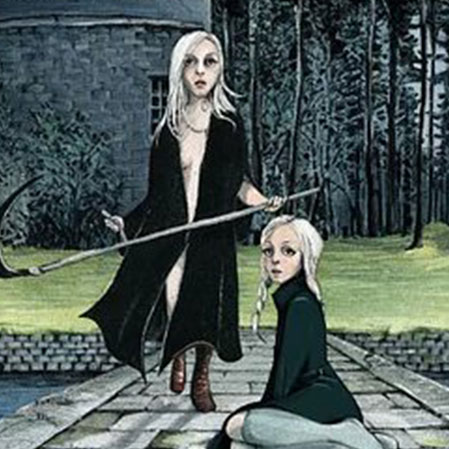BY: Sarah Garofalo
Starring: Robert Barger Jr., Royce Hobson, Matthew Ewald
Written and Directed by: Tracy Lee Staton
Roadkill Entertainment
TERROR IN WOODS CREEK has all the makings of an ultra-low budget, 80s slasher flick. With what there was to work with, a pretty admirable job was done to capture B movie feel. That being said, this flick leaves quite a bit to be desired, creating a mildly confusing plot and unlikeable and static characters that we don’t hate or love; we just simply don’t care about.
Tracy Lee Staton’s first feature film follows the happenings of the small town of Woods Creek, 50 years after a tragedy wiped out many of the town’s citizens. In 1962, a wave of darkness fell over Woods Creek causing the people of the town to either kill themselves or kill each other. The film opens with an eerie, home-movie esque scene, showing a shocking kill, and therefore introducing the movie’s main force of the evil: the drifter (Royce Hobson). In true slasher mystery fashion, the film’s perspective drifts between a detective’s search for answers, a douchey dudes search for power, and killers search for even more blood.
Arguably acting as one of the best components of TERROR IN WOODS CREEK, the drifter is the demonic darkness that has descended upon the town for the second time. While we aren’t given much information on who this creature is, why he came to this town in the first place, or why he’s decided to sport some of the wildest lookin’ side burns I’ve ever seen, Hobson does his best to make this purely evil creature as haunting as possible. The drifter acts as the very influence that causes both the suicides and murders carried out by an axe murderer known as Potato Sack Jack.
TERROR IN WOODS CREEK definitely follows the played out character tropes of the mystery slasher films that have come before it. The film comes equipped with an alcoholic, no-nonsense detective (Robert Barger Jr.), a plucky and determined, but often annoying journalist (Jacyln Vames), and an abusive, angry grease monkey (Matthew Ewald). Add in useless cops, a priest trying to keep the peace, and two kids killed within the first minutes of the film, and you’ve got a B slasher film that you’ve probably seen before.
While this film didn’t pack many major spooks or awes, the special effects, done by Mariah Johnson and Michael Barber were shocking and gruesome in the best way. The slashes and cuts on the victims were extremely well done, especially when considering the budget and the rest of the visuals of the film. The zombie wife character in particular was so impressive that I didn’t even question the presence of the undead in a slasher film.
Overall, TERROR IN WOODS CREEK has the bones of good ol’ fashioned slasher flick, but the execution makes it feel more like a first draft, rather than a final film. It was interesting to see Staton’s perspective, and her take on a modern, serial killer thriller. However, unlike the drifter, I don’t think I’ll be coming back for another round, but I did have an enjoyable ride.
https://youtu.be/S86j9ywjNPc
The world of dark-ambient, synthesizer-based music is one that continues to expand on a daily basis, whether it’s the increasingly popular 1980s-obsessed synthwave or the current crop of obscure dungeon-synth acts crowding sites like Bandcamp or Soundcloud. Many of these are heavily inspired by previous artists, be they John Carpenter, Klaus Schulze or even Mortiis. The common thread is that many of these artists are simply aping—albeit very well—the sounds of the past, with originality occasionally taking a back seat to homage and nostalgia. This is where Somerville, Massachusetts’ Missionary Work comes in. This project’s debut album SEVEN SERMONS, for Death Wound Zine’s new label venture (order it here), is something very fresh and exciting. Of course, the usual suspects are present and accounted for when it comes to conceptual influences, including Fabio Frizzi and Tangerine Dream, but Missionary Work composer Renato Montenegro takes his work one step further by incorporating influences beyond those of traditional synth-horror scores. For starters, there are marked influences from classical music, particularly the sort of bizarre, baroque tunes found on some of the more experimental Bruton library-music LPs. Montenegro feels right at home delving into Mike Oldfield- or Rick Wakeman-styled craziness on tracks like “Wickedness and Reverie” or “The Bishop’s Servant,” while “Sacrementi” and “King Shepherd (Cruel Shepherd)” provide more of the chilling atmosphere one might expect, given Montenegro’s appreciation of Lucio Fulci and his films.
“The project needs one last injection of funds to bring it to life in full, vibrant color.”
It’s the songwriting on SEVEN SERMONS that is most impressive, however; Montenegro is operating at quite an accomplished level. There has been clear care and thought given to how these songs are arranged, and how each track is structured in a fashion tailor-made for the live area. The closest comparison could perhaps be Zombi, but the progressive leanings are presented in a slightly different, less overtly rhythmic way. Although there is a propulsive feeling to Missionary Work, it takes a back seat to this sort of aquatic, mind-expanding synth orchestra.
Cover designed by Mondo illustrator Jessica Seamans
SEVEN SERMONS is one satisfying listening experience, and one which truly benefits from repeated spins. This is an album that pays dividends over time, but that can also be enjoyed in small chunks and short bursts. It would be disingenuous to compare Missionary Work with much of the current synthwave crop, and Montenegro is doing a fine job at carving out a niche for himself as one of the most promising talents of the indie electronic scene. Let’s just refer to Missionary Work as something intriguing, progressive and profoundly enjoyable—the sort of artist for whom many fans of dark, horror-influenced neo-soundtrack tunes have been waiting.
“includes perhaps the most intriguing extra of all: a limited-edition Jean Rollin board game”






